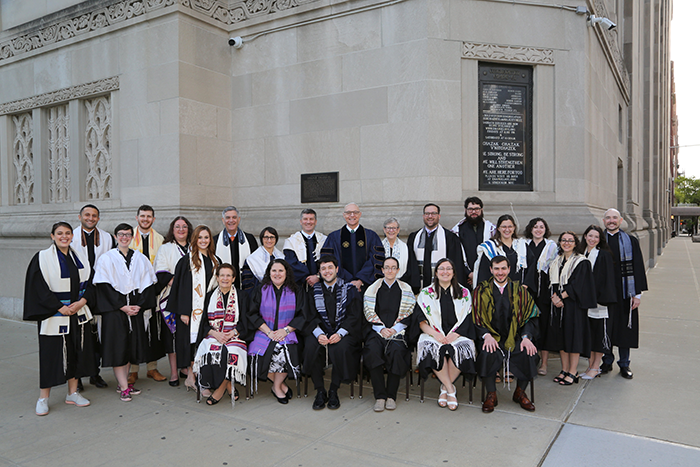Opinion
Relationship means showing up
Quietly eyeing the exit door or seeking renewal
In Short
Rabbis want to teach, to inspire, to shape lives
The second pandemic-era High Holy Days in North American Jewish life is behind us. Once again, rabbis in congregations and Jewish organizations across the country successfully found new and creative ways to bring their communities together during this sacred time. But even if your synagogue or Jewish organization made this process look seamless on the outside, you can be sure that on the inside, the work is demanding and grueling.
Congregations and organizations in some ways operate like small businesses; they have to bring in enough revenue to meet their expenses and make payroll, and they have to keep their stakeholders (such as congregants or donors) satisfied and engaged. But unlike many businesses, these institutions have often had to respond to the economic, logistical and cultural shocks of the pandemic without key infrastructure, such as H.R. departments, I.T. staff and other talent on a deep staff bench. Even large congregations are generally understaffed for their own level of program and activity. The end result is that rabbis themselves face a large and ever-growing list of demands and responsibilities, which may be pushing us toward a major crisis within Jewish institutions.


HUC-JIR/Richard Lobell
Here are the observable facts for congregations and organizations that rely on rabbis to lead them or to serve in any role on their staffs: a) we will be facing an unprecedented number of rabbinic positions being vacated in the next years as the baby boomer generation reaches retirement age; b) for the last decade, we have seen increasingly smaller numbers of those entering rabbinical school and being ordained. Both of these trends suggest that the roles that many institutions are counting on their rabbis to fill right now may be left vacant as the overall number of rabbis shrinks.
But it’s not just a wave of retirements or a lack of new rabbis we need to be worried about. Those rabbis who are currently in the middle years of their career, productive, creative, fulfilled in their work, have been chronically stretched for two years now. They feel overburdened and burnout by long hours for months on end, increased childcare issues, and ever-growing demands to master technology that was not in their budget, skillset, or vision. After facing all this for two years now, many may be looking in the mirror, asking themselves, “Can I continue doing this for 20 more years?” If you knew how many good, fulfilled rabbis are asking this question in their souls, with their spouse or partner, and to one another, you would sense that seismic shockwave that potentially faces us. It could even be going on within your own congregation or organization.
Yet in the face of these great concerns, there are steps that lay leaders of Jewish organizations can take to help mitigate this trend and ensure that the rabbis and other staff within their institutions are appropriately supported. The first is simply to acknowledge and articulate the chronic burden that rabbis and institutional staff are facing right now. Let them know that you see how much they have done for you, and that their efforts and care are valued and appreciated. Send a note, make a call, even a small gesture that acknowledges the challenges and the appreciation that you personally feel. What cannot be changed in the demands of the job can be mitigated by the fulfillment that being appreciated and valued brings. That is especially important for a rabbi, who enters the rabbinate for a sense of meaning.
These expressions of appreciation should be accompanied by tangible forms of support and benefits. The most obvious form is financial compensation, such as a bonus or a pay raise. While congregational and organizational budgets are stretched thin, working with donors to make that additional investment in existing personnel is almost always less expensive than a search for a new rabbi and relocation costs. Beyond direct compensation, offering other tangible gestures such as increased family time, flexibility of schedule, resources for renewal like time for study or professional development, or even just a few days of extra vacation can help show rabbis that they are valued and allow them to find some individual renewal.
Another key step Jewish leaders can take is to find ways to reprioritize, to be flexible with goals, timetables and expectations. In addition to their official work, rabbis and organizational staff are dealing with an ongoing crisis of reinvention, which creates an added burden that can make their existing responsibilities more difficult. And when mistakes do occur or deadlines slip, it’s also important to remember that rabbis are human and to forgive those imperfections; your rabbi probably does that for you.
Finally, it’s important for Jewish leaders to truly show up—virtually and physically. Rabbis want to teach, to inspire, to shape lives. Rabbis aren’t just trying to navigate the difficult issues of work-life balance, but make their work itself spiritually fulfilling, both for themselves as well as for the congregations and communities they serve. Come to services, classes, programs, community events not because you have to, but because relationship means showing up. Be there physically to find fulfillment in community but also to bring a sense of fulfillment to your rabbis in their work.
In our communal prayers for our congregations, we pray these words: “May those who teach and nourish us be blessed with satisfaction, and may we appreciate their time and their devotion.” It is now in our hands, and on our lips, to make our prayers real by giving our rabbis and institutional staff the appreciation and support they need.
Rabbi Lewis Kamrass is currently serving as the president of the Central Conference of American Rabbis, the 2200-member organization of Reform rabbis, and the senior Rabbi of Isaac M. Wise Temple, Cincinnati Ohio for the last 36 years.












